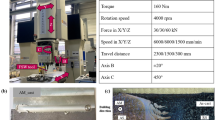Abstract
Nowadays small scale resistance spot welding is used frequently because of the requirements of miniaturization in industries. It is known that contact resistance is the most essential factor in heat generation process. In this study a new equation is provided to calculate the electrical contact resistance that does not require the number of contact points, the size, shape and distribution of them. To perform a simulation of the process, resistance spot welding is considered as an electrical-thermal-mechanical process in the finite element model. The simulation is done using a three dimensional model in COMSOL Multiphysics. The results of the simulation work are validated through performing experimental validation on Hastelloy X sheets. A new set-up is designed and constructed to study the effects of parameters in small scale resistance spot welding. Also, the relationships between mechanical properties and weld nugget dimensions and process parameters such as electrode force, welding current and welding time is evaluated. A DOE analysis is carried out to verify the significance of input factors on the nugget diameter, maximum load and nugget height. It was concluded that the nugget diameter increases with increasing time of current passing and decreases with increasing force. Also, increasing the current increases the nugget diameter. The maximum strength is obtained by applying maximum force, maximum time and minimum up to moderate currents. Optical metallography results demonstrated primary carbides (M6C) at the base metal and widmanstatten platelets at the weld area. It was found out that the maximum hardness occurs in the weld area.





















Similar content being viewed by others
References
Zhou Y, Gorman P, Tan W, Ely KJ (2000) Weldability of thin sheet metals during small-scale resistance spot welding using an alternating-current power supply. J Electron Mater 29:1090–1099
Ely KJ, Zhou Y (2001) Microresistance spot welding of Kovar, steel, and nickel. Sci. Technol. Weld. Joi. 6(2):63–72
Chen YC, Tseng KH, Cheng YS (2012) Electrode displacement and dynamic resistance during small-scale resistance spot welding. Adv Sci Lett 11:72–79
Tan W, Zhou Y, Kerr HW, Lawson S (2004) A study of dynamic resistance during small scale resistance spot welding of thin Ni sheets. J Phys D Appl Phys 37:1998–2008
Chang BH, Li MV, Zhou Y (2001) Comparative study of small scale and large scale resistance spot welding. Sci Technol Weld Joi 6(5):273–280
Chang BH, Zhou Y (2003) Numerical study on the effect of electrode force in small-scale resistance spot welding. J Mater Process Tech 139:635–641
Zhao D, Wang Y, Sheng S, Lin Z (2013) Multi-objective optimal design of small scale resistance spot welding process with principal component analysis and response surface methodology. J Intell Manuf. https://doi.org/10.1007/s10845-013-0733-2
Browne DJ, Chandler HW, Evans JT, Wen J (1995) Computer simulation of resistance spot welding in aluminium: part I. Weld J 74(10):339–344
Feng, Z., Gould, J. E., Babu, S. S., Santella, M. L., Riemer, B. W. (1998) An incrementally coupled electrical-thermal-mechanical model for resistance spot welding. In: Vitek, J. M. et al. (eds.) Trends in Welding Research, Proc. of 5th Int. Conf. on Trends in Welding Research, pp. 599–604. ASM Int., Materials Park: Pine Mountain, OH, GA, Cleveland
Hamedi M, Atashparva M (2017) A review of electrical contact resistance modeling in resistance spot welding. Weld World 61:269–290
Tsai CL, Jammal O, Papritan JC, Dickinson DW (1992) Modeling of resistance spot welding nugget growth. Weld J 71:47–54
Wen J, Wang CS, Xu GC, Zhang XQ (2009) Real time monitoring weld quality of resistance spot welding for stainless steel. ISIJ Int 49:553–556
Author information
Authors and Affiliations
Corresponding author
Rights and permissions
About this article
Cite this article
Atashparva, M., Hamedi, M. Investigating Mechanical Properties of Small Scale Resistance Spot Welding of a Nickel Based Superalloy through Statistical DOE. Exp Tech 42, 27–43 (2018). https://doi.org/10.1007/s40799-017-0221-2
Received:
Accepted:
Published:
Issue Date:
DOI: https://doi.org/10.1007/s40799-017-0221-2




